ICT103 System Analysis and Design: System Analysis and Design Report
VerifiedAdded on 2023/05/28
|10
|1785
|235
Report
AI Summary
This report provides a comprehensive analysis of system analysis and design methodologies, focusing on the System Development Life Cycle (SDLC) and its predictive and adaptive approaches. It evaluates the usefulness and limitations of each approach, selecting the agile method as suitable for the IT Solutions case study. The report discusses requirement gathering techniques such as interviews and questionnaires, detailing functional and non-functional requirements for the system. Furthermore, it includes a requirement modeling section with assumptions and an activity diagram to graphically illustrate the new system. The analysis concludes that the agile method ensures a promising system development outcome, enhancing communication and service handling between IT Solutions and its clients.

Paraphrase This Document
Need a fresh take? Get an instant paraphrase of this document with our AI Paraphraser

System analysis and design
|
|
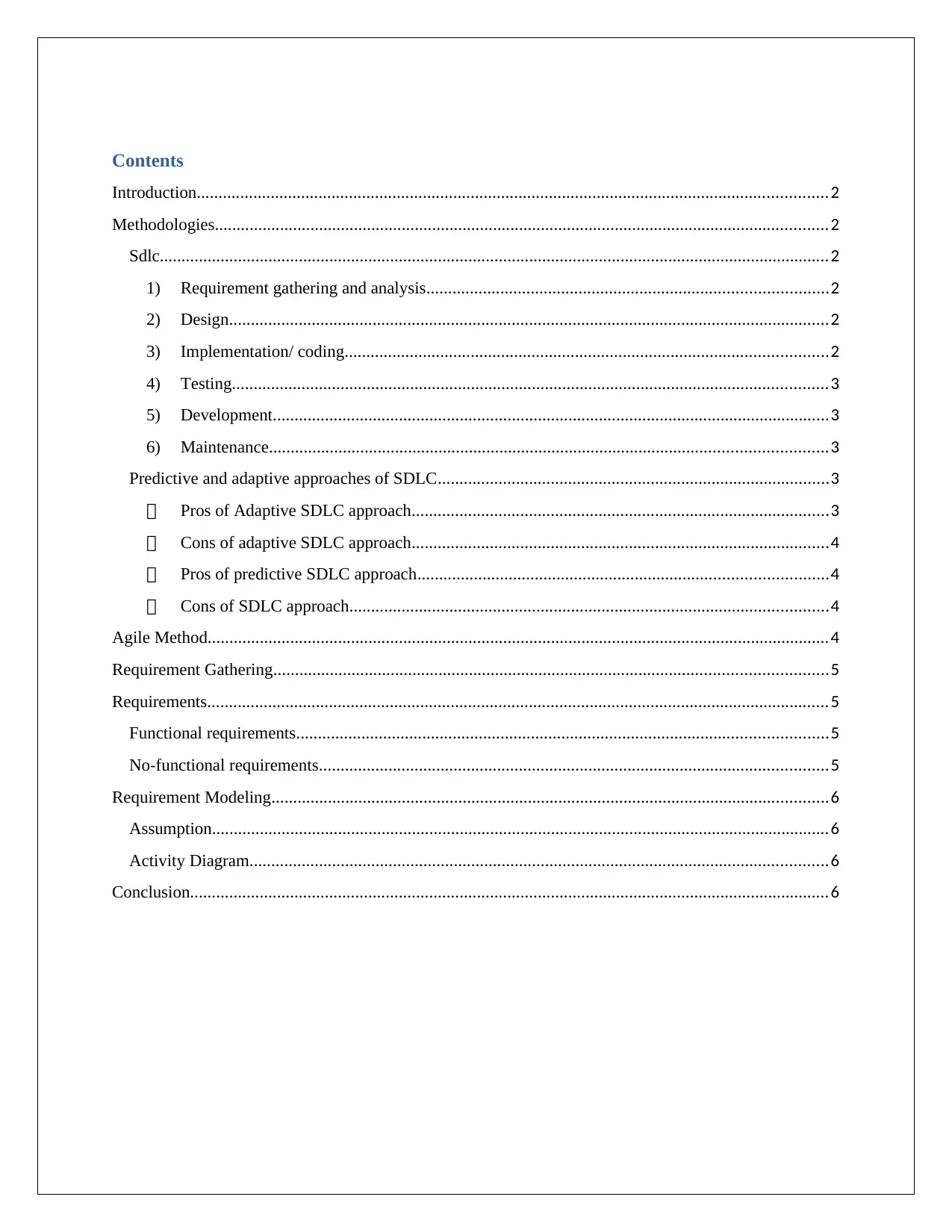
Contents
Introduction.................................................................................................................................................2
Methodologies.............................................................................................................................................2
Sdlc..........................................................................................................................................................2
1) Requirement gathering and analysis............................................................................................2
2) Design..........................................................................................................................................2
3) Implementation/ coding...............................................................................................................2
4) Testing.........................................................................................................................................3
5) Development................................................................................................................................3
6) Maintenance................................................................................................................................3
Predictive and adaptive approaches of SDLC..........................................................................................3
Pros of Adaptive SDLC approach................................................................................................3
Cons of adaptive SDLC approach................................................................................................4
Pros of predictive SDLC approach..............................................................................................4
Cons of SDLC approach..............................................................................................................4
Agile Method...............................................................................................................................................4
Requirement Gathering...............................................................................................................................5
Requirements...............................................................................................................................................5
Functional requirements..........................................................................................................................5
No-functional requirements.....................................................................................................................5
Requirement Modeling................................................................................................................................6
Assumption..............................................................................................................................................6
Activity Diagram.....................................................................................................................................6
Conclusion...................................................................................................................................................6
Introduction.................................................................................................................................................2
Methodologies.............................................................................................................................................2
Sdlc..........................................................................................................................................................2
1) Requirement gathering and analysis............................................................................................2
2) Design..........................................................................................................................................2
3) Implementation/ coding...............................................................................................................2
4) Testing.........................................................................................................................................3
5) Development................................................................................................................................3
6) Maintenance................................................................................................................................3
Predictive and adaptive approaches of SDLC..........................................................................................3
Pros of Adaptive SDLC approach................................................................................................3
Cons of adaptive SDLC approach................................................................................................4
Pros of predictive SDLC approach..............................................................................................4
Cons of SDLC approach..............................................................................................................4
Agile Method...............................................................................................................................................4
Requirement Gathering...............................................................................................................................5
Requirements...............................................................................................................................................5
Functional requirements..........................................................................................................................5
No-functional requirements.....................................................................................................................5
Requirement Modeling................................................................................................................................6
Assumption..............................................................................................................................................6
Activity Diagram.....................................................................................................................................6
Conclusion...................................................................................................................................................6
⊘ This is a preview!⊘
Do you want full access?
Subscribe today to unlock all pages.

Trusted by 1+ million students worldwide
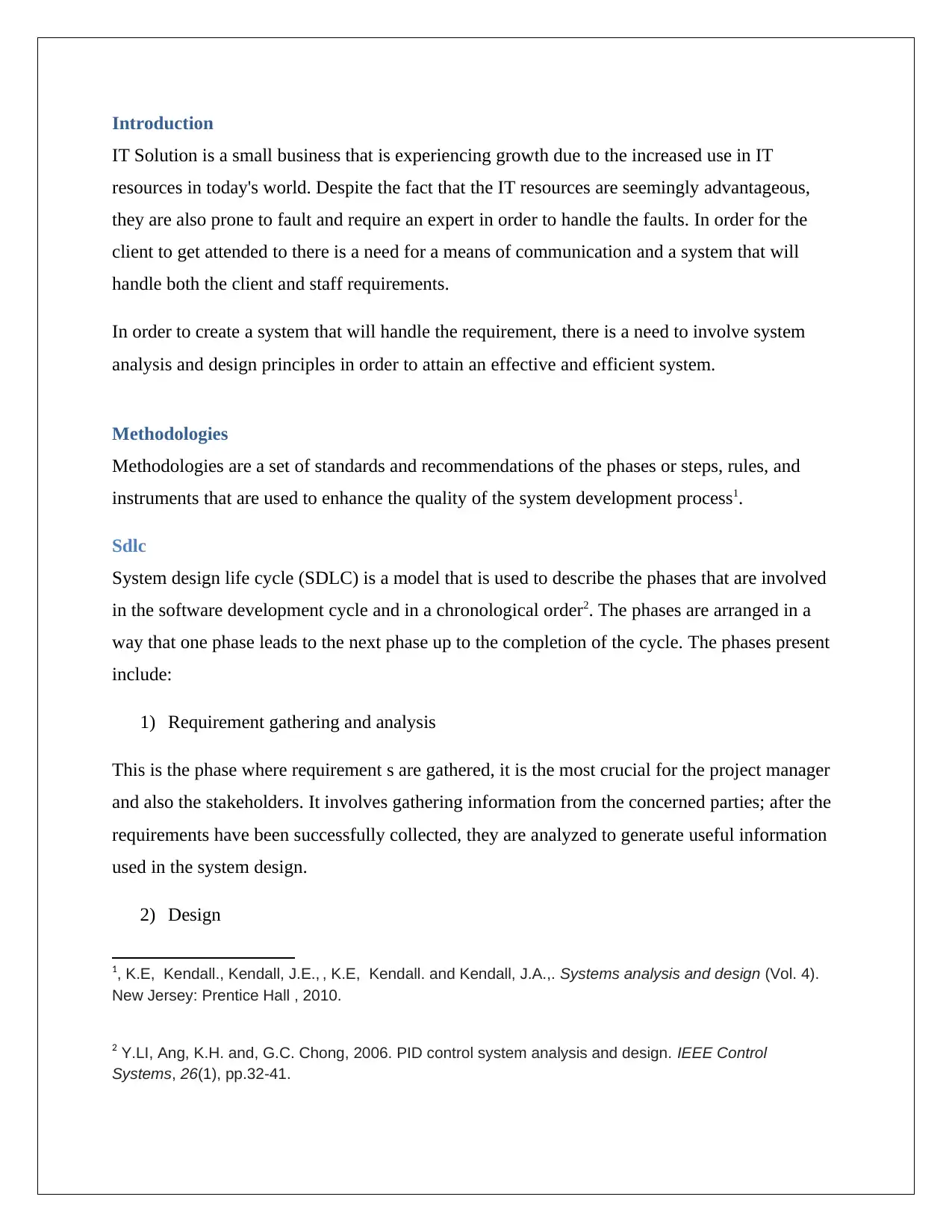
Introduction
IT Solution is a small business that is experiencing growth due to the increased use in IT
resources in today's world. Despite the fact that the IT resources are seemingly advantageous,
they are also prone to fault and require an expert in order to handle the faults. In order for the
client to get attended to there is a need for a means of communication and a system that will
handle both the client and staff requirements.
In order to create a system that will handle the requirement, there is a need to involve system
analysis and design principles in order to attain an effective and efficient system.
Methodologies
Methodologies are a set of standards and recommendations of the phases or steps, rules, and
instruments that are used to enhance the quality of the system development process1.
Sdlc
System design life cycle (SDLC) is a model that is used to describe the phases that are involved
in the software development cycle and in a chronological order2. The phases are arranged in a
way that one phase leads to the next phase up to the completion of the cycle. The phases present
include:
1) Requirement gathering and analysis
This is the phase where requirement s are gathered, it is the most crucial for the project manager
and also the stakeholders. It involves gathering information from the concerned parties; after the
requirements have been successfully collected, they are analyzed to generate useful information
used in the system design.
2) Design
1, K.E, Kendall., Kendall, J.E., , K.E, Kendall. and Kendall, J.A.,. Systems analysis and design (Vol. 4).
New Jersey: Prentice Hall , 2010.
2 Y.LI, Ang, K.H. and, G.C. Chong, 2006. PID control system analysis and design. IEEE Control
Systems, 26(1), pp.32-41.
IT Solution is a small business that is experiencing growth due to the increased use in IT
resources in today's world. Despite the fact that the IT resources are seemingly advantageous,
they are also prone to fault and require an expert in order to handle the faults. In order for the
client to get attended to there is a need for a means of communication and a system that will
handle both the client and staff requirements.
In order to create a system that will handle the requirement, there is a need to involve system
analysis and design principles in order to attain an effective and efficient system.
Methodologies
Methodologies are a set of standards and recommendations of the phases or steps, rules, and
instruments that are used to enhance the quality of the system development process1.
Sdlc
System design life cycle (SDLC) is a model that is used to describe the phases that are involved
in the software development cycle and in a chronological order2. The phases are arranged in a
way that one phase leads to the next phase up to the completion of the cycle. The phases present
include:
1) Requirement gathering and analysis
This is the phase where requirement s are gathered, it is the most crucial for the project manager
and also the stakeholders. It involves gathering information from the concerned parties; after the
requirements have been successfully collected, they are analyzed to generate useful information
used in the system design.
2) Design
1, K.E, Kendall., Kendall, J.E., , K.E, Kendall. and Kendall, J.A.,. Systems analysis and design (Vol. 4).
New Jersey: Prentice Hall , 2010.
2 Y.LI, Ang, K.H. and, G.C. Chong, 2006. PID control system analysis and design. IEEE Control
Systems, 26(1), pp.32-41.
Paraphrase This Document
Need a fresh take? Get an instant paraphrase of this document with our AI Paraphraser
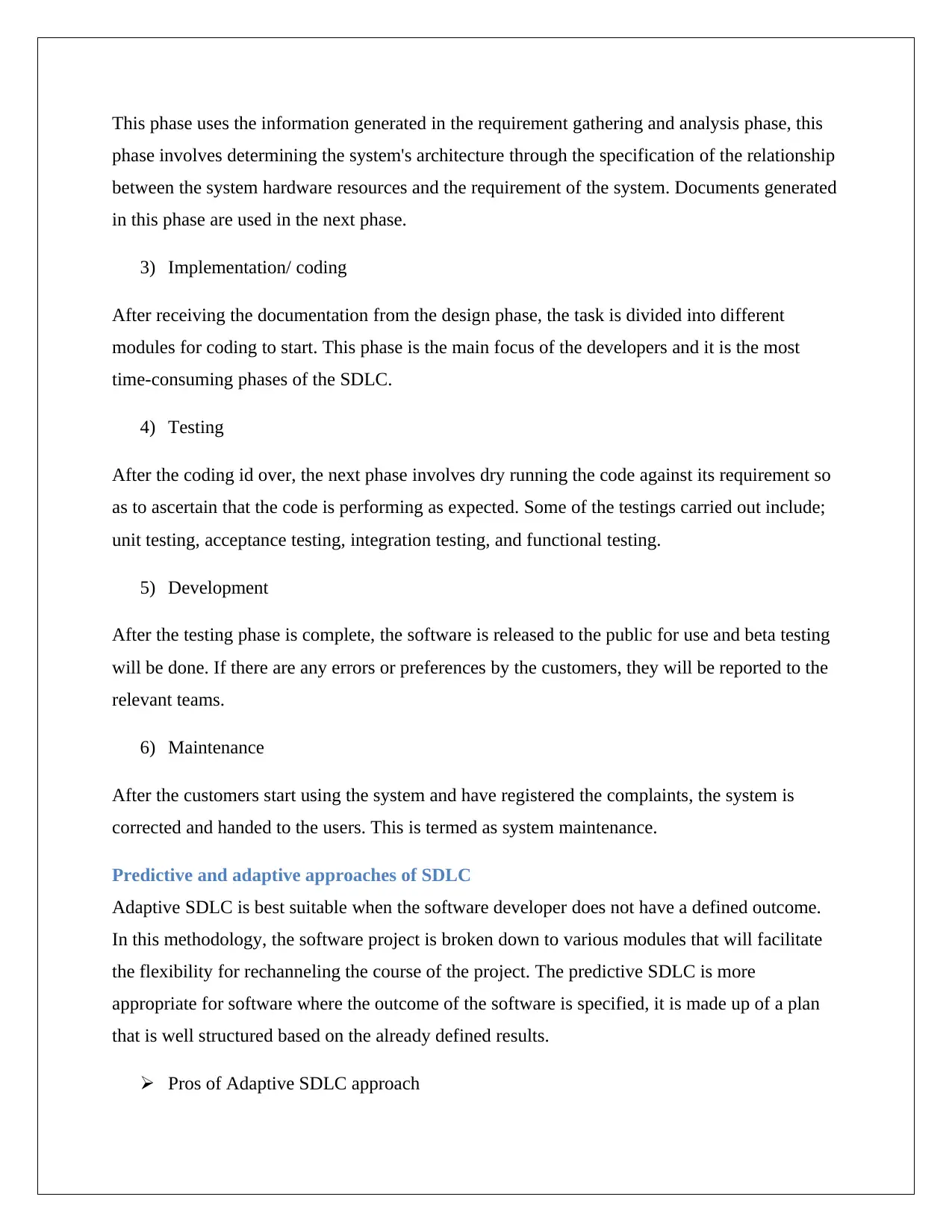
This phase uses the information generated in the requirement gathering and analysis phase, this
phase involves determining the system's architecture through the specification of the relationship
between the system hardware resources and the requirement of the system. Documents generated
in this phase are used in the next phase.
3) Implementation/ coding
After receiving the documentation from the design phase, the task is divided into different
modules for coding to start. This phase is the main focus of the developers and it is the most
time-consuming phases of the SDLC.
4) Testing
After the coding id over, the next phase involves dry running the code against its requirement so
as to ascertain that the code is performing as expected. Some of the testings carried out include;
unit testing, acceptance testing, integration testing, and functional testing.
5) Development
After the testing phase is complete, the software is released to the public for use and beta testing
will be done. If there are any errors or preferences by the customers, they will be reported to the
relevant teams.
6) Maintenance
After the customers start using the system and have registered the complaints, the system is
corrected and handed to the users. This is termed as system maintenance.
Predictive and adaptive approaches of SDLC
Adaptive SDLC is best suitable when the software developer does not have a defined outcome.
In this methodology, the software project is broken down to various modules that will facilitate
the flexibility for rechanneling the course of the project. The predictive SDLC is more
appropriate for software where the outcome of the software is specified, it is made up of a plan
that is well structured based on the already defined results.
Pros of Adaptive SDLC approach
phase involves determining the system's architecture through the specification of the relationship
between the system hardware resources and the requirement of the system. Documents generated
in this phase are used in the next phase.
3) Implementation/ coding
After receiving the documentation from the design phase, the task is divided into different
modules for coding to start. This phase is the main focus of the developers and it is the most
time-consuming phases of the SDLC.
4) Testing
After the coding id over, the next phase involves dry running the code against its requirement so
as to ascertain that the code is performing as expected. Some of the testings carried out include;
unit testing, acceptance testing, integration testing, and functional testing.
5) Development
After the testing phase is complete, the software is released to the public for use and beta testing
will be done. If there are any errors or preferences by the customers, they will be reported to the
relevant teams.
6) Maintenance
After the customers start using the system and have registered the complaints, the system is
corrected and handed to the users. This is termed as system maintenance.
Predictive and adaptive approaches of SDLC
Adaptive SDLC is best suitable when the software developer does not have a defined outcome.
In this methodology, the software project is broken down to various modules that will facilitate
the flexibility for rechanneling the course of the project. The predictive SDLC is more
appropriate for software where the outcome of the software is specified, it is made up of a plan
that is well structured based on the already defined results.
Pros of Adaptive SDLC approach
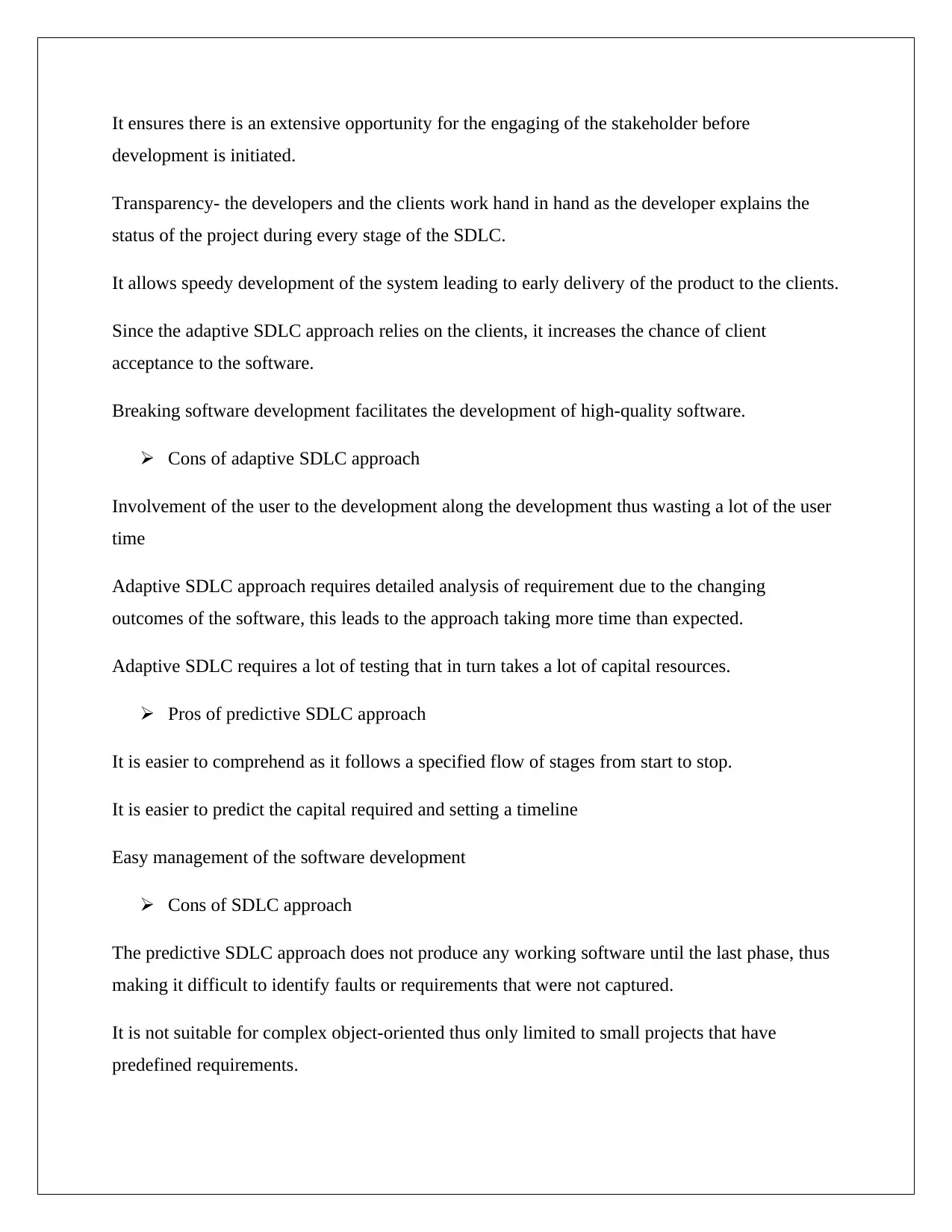
It ensures there is an extensive opportunity for the engaging of the stakeholder before
development is initiated.
Transparency- the developers and the clients work hand in hand as the developer explains the
status of the project during every stage of the SDLC.
It allows speedy development of the system leading to early delivery of the product to the clients.
Since the adaptive SDLC approach relies on the clients, it increases the chance of client
acceptance to the software.
Breaking software development facilitates the development of high-quality software.
Cons of adaptive SDLC approach
Involvement of the user to the development along the development thus wasting a lot of the user
time
Adaptive SDLC approach requires detailed analysis of requirement due to the changing
outcomes of the software, this leads to the approach taking more time than expected.
Adaptive SDLC requires a lot of testing that in turn takes a lot of capital resources.
Pros of predictive SDLC approach
It is easier to comprehend as it follows a specified flow of stages from start to stop.
It is easier to predict the capital required and setting a timeline
Easy management of the software development
Cons of SDLC approach
The predictive SDLC approach does not produce any working software until the last phase, thus
making it difficult to identify faults or requirements that were not captured.
It is not suitable for complex object-oriented thus only limited to small projects that have
predefined requirements.
development is initiated.
Transparency- the developers and the clients work hand in hand as the developer explains the
status of the project during every stage of the SDLC.
It allows speedy development of the system leading to early delivery of the product to the clients.
Since the adaptive SDLC approach relies on the clients, it increases the chance of client
acceptance to the software.
Breaking software development facilitates the development of high-quality software.
Cons of adaptive SDLC approach
Involvement of the user to the development along the development thus wasting a lot of the user
time
Adaptive SDLC approach requires detailed analysis of requirement due to the changing
outcomes of the software, this leads to the approach taking more time than expected.
Adaptive SDLC requires a lot of testing that in turn takes a lot of capital resources.
Pros of predictive SDLC approach
It is easier to comprehend as it follows a specified flow of stages from start to stop.
It is easier to predict the capital required and setting a timeline
Easy management of the software development
Cons of SDLC approach
The predictive SDLC approach does not produce any working software until the last phase, thus
making it difficult to identify faults or requirements that were not captured.
It is not suitable for complex object-oriented thus only limited to small projects that have
predefined requirements.
⊘ This is a preview!⊘
Do you want full access?
Subscribe today to unlock all pages.

Trusted by 1+ million students worldwide

Agile Method
An agile method is an adaptive approach of SDLC. The involvement of the client feedback and
continuous planning enable the developers to ensure that the values of the system are enhanced
along the development process. The agile method will be best suitable for developing the IT
Solution system. The final result of the system will be much better to cater to the requirements of
the staff and the customers.
Requirement Gathering
Based on the case study, the best requirement gathering techniques that can be used include the
use of questionnaires and interviews. An interview is time-consuming and is more suitable for
handling a small number. This technique will be used on the IT Solution staff and a sample of its
clients; this will allow qualitative requirement gathering from the involved parties3.
Use of questionnaires will be effective for a large population to gather requirements from. This
method will enable the IT Solution to gather requirement from a majority of its clients. This
technique will yield a quantitative Study Of The Concerned Parties.
Requirements
Functional requirements
Clients should be able to create a customer account in the IT Solution system.
Clients that have an account should be able to log in.
The client should be able directly enter their service request.
Clients should be able to get feedback based on their request.
The staff members should be able to get the request.
Staff should be able to respond to the client.
The system should be able to keep track of what each staff has done.
System should be able to involve a second consultant if the first consultant finds it
complex.
3K.E, Kendall and J.E, Kendall. Systems analysis and design. Prentice Hall Press, 2010
An agile method is an adaptive approach of SDLC. The involvement of the client feedback and
continuous planning enable the developers to ensure that the values of the system are enhanced
along the development process. The agile method will be best suitable for developing the IT
Solution system. The final result of the system will be much better to cater to the requirements of
the staff and the customers.
Requirement Gathering
Based on the case study, the best requirement gathering techniques that can be used include the
use of questionnaires and interviews. An interview is time-consuming and is more suitable for
handling a small number. This technique will be used on the IT Solution staff and a sample of its
clients; this will allow qualitative requirement gathering from the involved parties3.
Use of questionnaires will be effective for a large population to gather requirements from. This
method will enable the IT Solution to gather requirement from a majority of its clients. This
technique will yield a quantitative Study Of The Concerned Parties.
Requirements
Functional requirements
Clients should be able to create a customer account in the IT Solution system.
Clients that have an account should be able to log in.
The client should be able directly enter their service request.
Clients should be able to get feedback based on their request.
The staff members should be able to get the request.
Staff should be able to respond to the client.
The system should be able to keep track of what each staff has done.
System should be able to involve a second consultant if the first consultant finds it
complex.
3K.E, Kendall and J.E, Kendall. Systems analysis and design. Prentice Hall Press, 2010
Paraphrase This Document
Need a fresh take? Get an instant paraphrase of this document with our AI Paraphraser
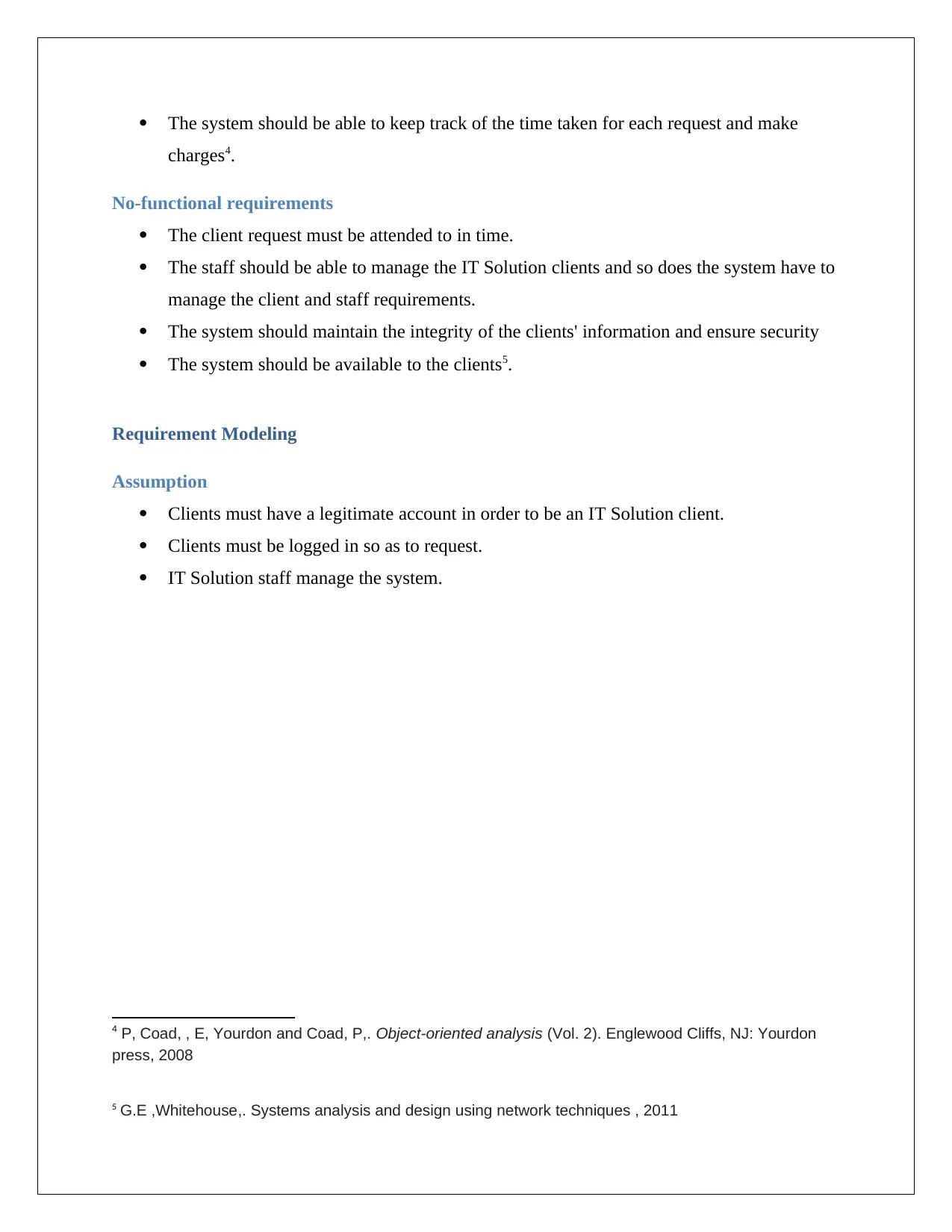
The system should be able to keep track of the time taken for each request and make
charges4.
No-functional requirements
The client request must be attended to in time.
The staff should be able to manage the IT Solution clients and so does the system have to
manage the client and staff requirements.
The system should maintain the integrity of the clients' information and ensure security
The system should be available to the clients5.
Requirement Modeling
Assumption
Clients must have a legitimate account in order to be an IT Solution client.
Clients must be logged in so as to request.
IT Solution staff manage the system.
4 P, Coad, , E, Yourdon and Coad, P,. Object-oriented analysis (Vol. 2). Englewood Cliffs, NJ: Yourdon
press, 2008
5 G.E ,Whitehouse,. Systems analysis and design using network techniques , 2011
charges4.
No-functional requirements
The client request must be attended to in time.
The staff should be able to manage the IT Solution clients and so does the system have to
manage the client and staff requirements.
The system should maintain the integrity of the clients' information and ensure security
The system should be available to the clients5.
Requirement Modeling
Assumption
Clients must have a legitimate account in order to be an IT Solution client.
Clients must be logged in so as to request.
IT Solution staff manage the system.
4 P, Coad, , E, Yourdon and Coad, P,. Object-oriented analysis (Vol. 2). Englewood Cliffs, NJ: Yourdon
press, 2008
5 G.E ,Whitehouse,. Systems analysis and design using network techniques , 2011
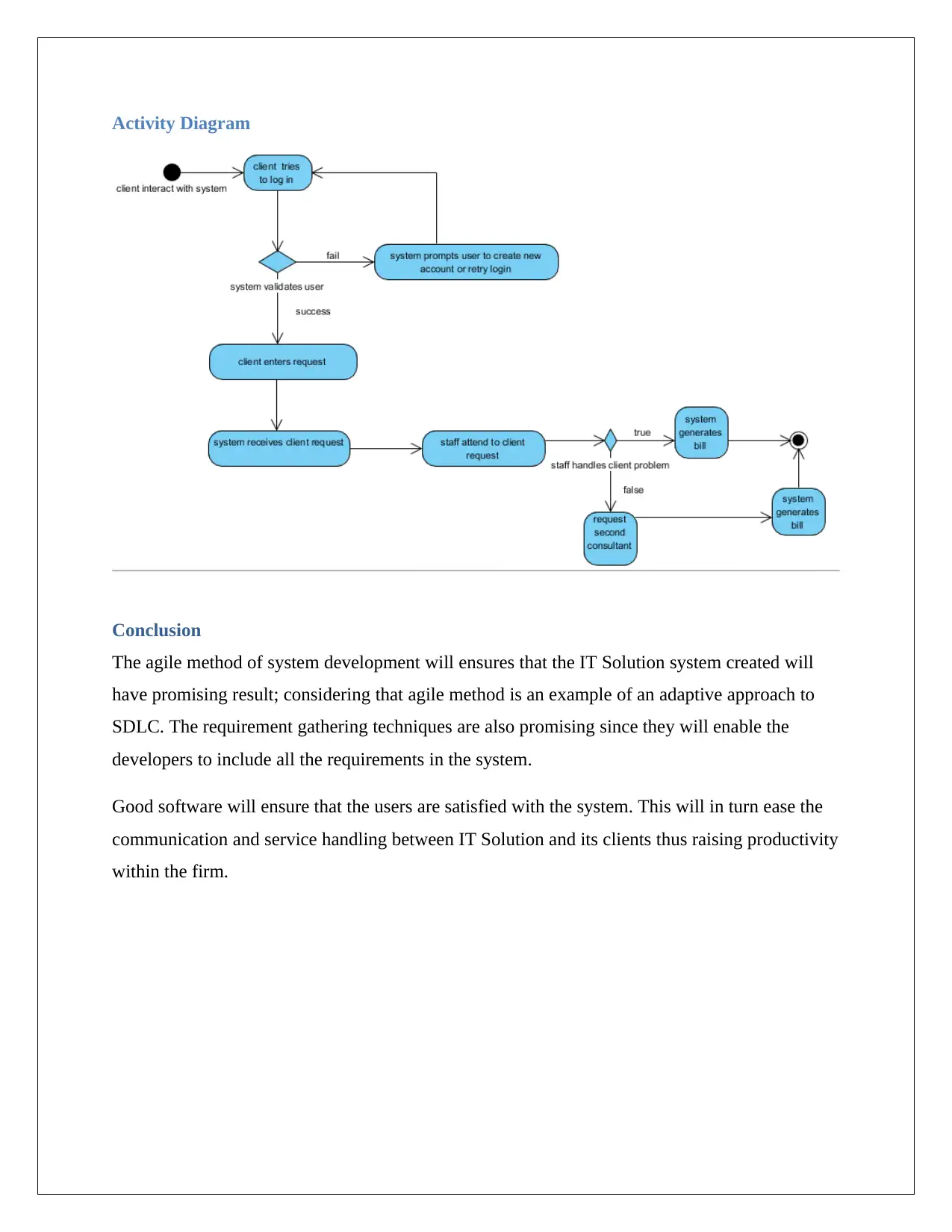
Activity Diagram
Conclusion
The agile method of system development will ensures that the IT Solution system created will
have promising result; considering that agile method is an example of an adaptive approach to
SDLC. The requirement gathering techniques are also promising since they will enable the
developers to include all the requirements in the system.
Good software will ensure that the users are satisfied with the system. This will in turn ease the
communication and service handling between IT Solution and its clients thus raising productivity
within the firm.
Conclusion
The agile method of system development will ensures that the IT Solution system created will
have promising result; considering that agile method is an example of an adaptive approach to
SDLC. The requirement gathering techniques are also promising since they will enable the
developers to include all the requirements in the system.
Good software will ensure that the users are satisfied with the system. This will in turn ease the
communication and service handling between IT Solution and its clients thus raising productivity
within the firm.
⊘ This is a preview!⊘
Do you want full access?
Subscribe today to unlock all pages.

Trusted by 1+ million students worldwide
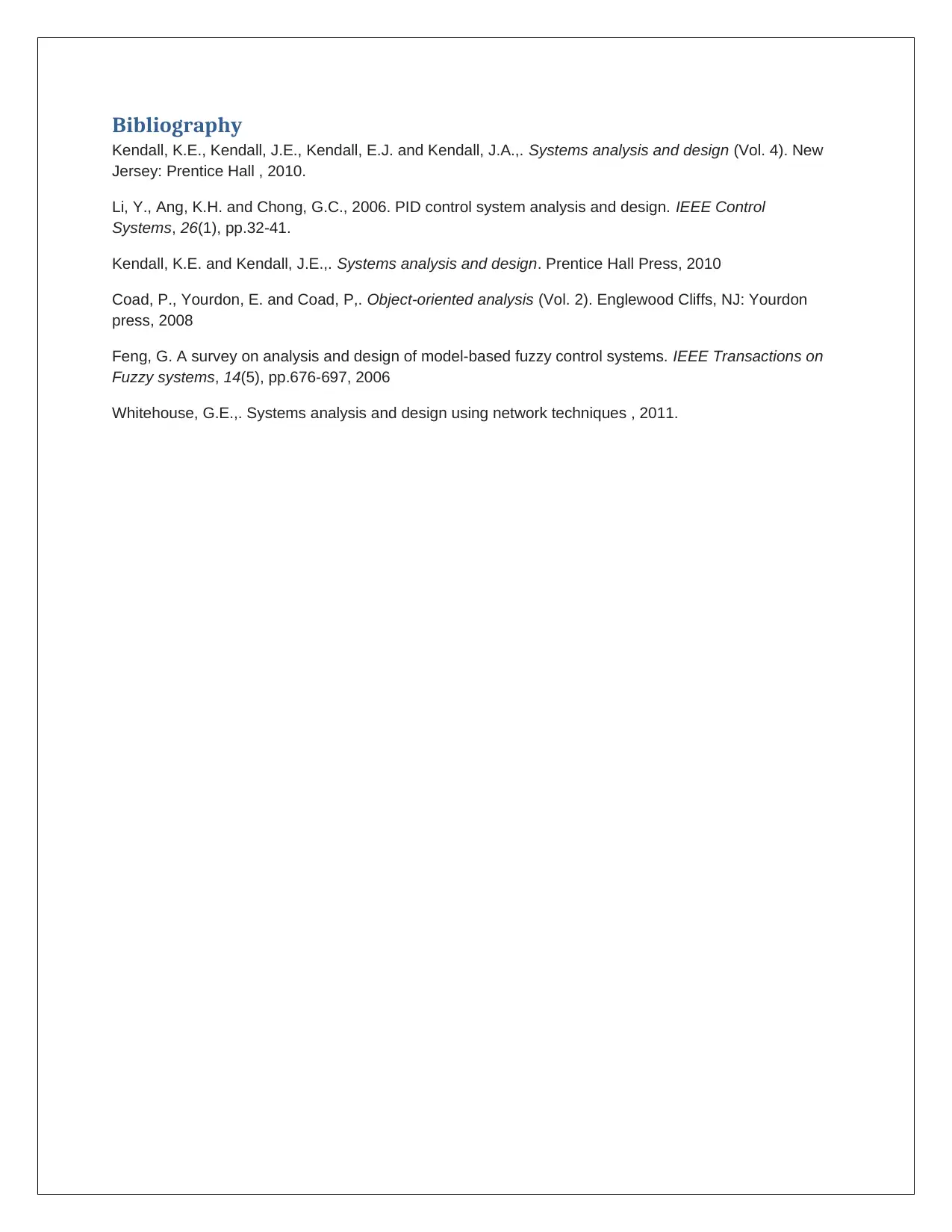
Bibliography
Kendall, K.E., Kendall, J.E., Kendall, E.J. and Kendall, J.A.,. Systems analysis and design (Vol. 4). New
Jersey: Prentice Hall , 2010.
Li, Y., Ang, K.H. and Chong, G.C., 2006. PID control system analysis and design. IEEE Control
Systems, 26(1), pp.32-41.
Kendall, K.E. and Kendall, J.E.,. Systems analysis and design. Prentice Hall Press, 2010
Coad, P., Yourdon, E. and Coad, P,. Object-oriented analysis (Vol. 2). Englewood Cliffs, NJ: Yourdon
press, 2008
Feng, G. A survey on analysis and design of model-based fuzzy control systems. IEEE Transactions on
Fuzzy systems, 14(5), pp.676-697, 2006
Whitehouse, G.E.,. Systems analysis and design using network techniques , 2011.
Kendall, K.E., Kendall, J.E., Kendall, E.J. and Kendall, J.A.,. Systems analysis and design (Vol. 4). New
Jersey: Prentice Hall , 2010.
Li, Y., Ang, K.H. and Chong, G.C., 2006. PID control system analysis and design. IEEE Control
Systems, 26(1), pp.32-41.
Kendall, K.E. and Kendall, J.E.,. Systems analysis and design. Prentice Hall Press, 2010
Coad, P., Yourdon, E. and Coad, P,. Object-oriented analysis (Vol. 2). Englewood Cliffs, NJ: Yourdon
press, 2008
Feng, G. A survey on analysis and design of model-based fuzzy control systems. IEEE Transactions on
Fuzzy systems, 14(5), pp.676-697, 2006
Whitehouse, G.E.,. Systems analysis and design using network techniques , 2011.
1 out of 10
Related Documents
Your All-in-One AI-Powered Toolkit for Academic Success.
+13062052269
info@desklib.com
Available 24*7 on WhatsApp / Email
![[object Object]](/_next/static/media/star-bottom.7253800d.svg)
Unlock your academic potential
Copyright © 2020–2025 A2Z Services. All Rights Reserved. Developed and managed by ZUCOL.





